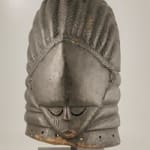Sande Society Mende Helmet Mask, 20th Century CE
Wood
9 x 14.75
PF.5464 (LSO)
Further images
This austere helmet mask was made by the Mende people of Sierra Leone. It pertains to the Sande women’s initiation society, which is the only all-female masking society in Africa....
This austere helmet mask was made by the Mende people of Sierra Leone. It pertains to the Sande women’s initiation society, which is the only all-female masking society in Africa. It is typical of the genre, with a cut-away face under a domed forehead, a pointed chin and a thick neck decorated with a series of rings. The eyes are closed/hooded, and the face is, unusually, decorated with incised pattern designs. The hair is rendered as a series of anteroposteriorly-oriented herringbone braids; complex hairstyles are considered beautiful by the Mende. The edge of the coiffure is marked with a band of incised marks which represent fecundity and attractiveness. The neck rings represent water, the home of the “Now” spirit (see below).
While currently under threat from the effect of Islamicism, Mende society was originally under the control of such groups, who controlled a sacred medicine known as halei, bestowed by deities upon the Mende and their close neighbours, the Gola. Control was maintained by displays of halei’s mysterious powers during “Now” dancing masquerades; initiates performed the sacred dances with these masks and long, dark costumes. The actual secrets of halei were never divulged, however. There were various levels of Sande initiation, and each had its own mask. The more ornate the mask, the higher the grade. Once made and endowed with magic through strategic application of oil and halei materials, the mask stays with the owner until she retires, dies, or is promoted.
These masks are rare and beautiful pieces of socially important African art.
While currently under threat from the effect of Islamicism, Mende society was originally under the control of such groups, who controlled a sacred medicine known as halei, bestowed by deities upon the Mende and their close neighbours, the Gola. Control was maintained by displays of halei’s mysterious powers during “Now” dancing masquerades; initiates performed the sacred dances with these masks and long, dark costumes. The actual secrets of halei were never divulged, however. There were various levels of Sande initiation, and each had its own mask. The more ornate the mask, the higher the grade. Once made and endowed with magic through strategic application of oil and halei materials, the mask stays with the owner until she retires, dies, or is promoted.
These masks are rare and beautiful pieces of socially important African art.











